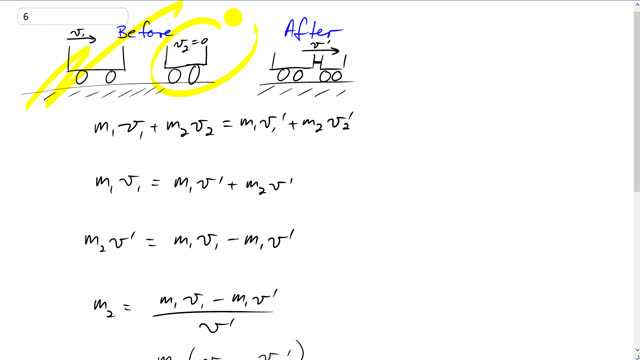
A 7700-kg boxcar traveling 14 m/s strikes a second car at rest. The two stick together and move off with a speed of 5.0 m/s. What is the mass of the second car?

In order to watch this solution you need to have a subscription.
This is Giancoli Answers with Mr. Dychko. Here's the before-collision picture where you have the box car moving with speed, v 1, approaching this second box car, which is initially at rest, so v 2 is 0; v 1 is 14 meters per second and this box car has a mass, m 1, of 7700 kilograms. And after the collision, they couple together and move off with some common velocity afterwards. And this single velocity afterwards, we'll just call v prime, there's no need for a v 1 prime or v 2 prime I have wrote it here just because this is the, you know, textbook conservation of momentum statement but given this question, we can instead write v 1 prime as v prime and v 2 prime as v prime because they both are the same since they move off as one common object with some common speed v prime. So v 2 is zero so this term disappears; this is the initial speed of this second rail car and it starts at rest so this term is gone so we can rewrite this as m 1v 1 equals m 1 times v prime plus m 2 times v prime. And we are gonna solve this for m 2 because that's the question, what is the mass of this second box car which was initially at rest? And so we'll move this term to the left hand side by subtracting it from both sides so that makes m 1v prime negative and then switch the sides around so we have this unknown m 2 on the left. So we have m 2v prime equals m 1v 1 minus m 1v prime and then divide both sides by v prime to isolate m 2. And to be even more fancy, we can factor out this common m 1 from both terms in the top and so we have m 1 times bracket v 1 minus v prime divided by v prime. So we have 7700 kilograms—mass of the initially moving box car— times its initial velocity, 14 meters per second, minus the 5.0 meters per second speed that they move off together with after colliding divided by 5 which gives 1.4 times 10 to the 4 kilograms must have been the mass of the box car which was at rest initially.